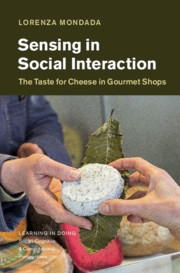Book contents
- Sensing in Social Interaction
- Learning in Doing: Social, Cognitive, and Computational Perspectives
- Sensing in Social Interaction
- Copyright page
- Contents
- Figures
- Tables
- Extracts
- Acknowledgments
- Part I Sensoriality in Interaction
- Part II Looking and Knowing
- 3 Looking for a Cheese
- 4 Asking for a Cheese: The Calibration of Looking and Knowing
- Part III Sensing Together
- Part IV Tasting, Assessing, and Making Decisions
- Appendix: Transcription Conventions
- Bibliography
- Index
- Series page
4 - Asking for a Cheese: The Calibration of Looking and Knowing
from Part II - Looking and Knowing
Published online by Cambridge University Press: 21 October 2021
- Sensing in Social Interaction
- Learning in Doing: Social, Cognitive, and Computational Perspectives
- Sensing in Social Interaction
- Copyright page
- Contents
- Figures
- Tables
- Extracts
- Acknowledgments
- Part I Sensoriality in Interaction
- Part II Looking and Knowing
- 3 Looking for a Cheese
- 4 Asking for a Cheese: The Calibration of Looking and Knowing
- Part III Sensing Together
- Part IV Tasting, Assessing, and Making Decisions
- Appendix: Transcription Conventions
- Bibliography
- Index
- Series page
Summary
An alternative way of initiating the purchase consists for the customer in requesting a specific product. The way requests are formatted, and the way they are produced by looking and possibly pointing at the products, displays whether the customer is a connoisseur or a novice, and project the relevant service expected. The seller provides for a differentiated response to requests displaying more or less knowledge of the requested product. Whereas customers knowing what they request just name the product and are fetched with it, customers not fully knowing what they request are responded to in a more expanded way by the seller. The seller engages in informing – providing a diversity of verbal information about the cheese, within an expert and relatively standardized discourse – and in showing the product, associating visual characteristics with verbal descriptions. When this is considered by the participants as an insufficient basis for decision-making, the seller offers them to taste the cheese. In this way, the access to the materiality of cheese is provided, depending on the sequential unfolding of the interaction, in a stepwise way ordering vision, talk, and closer sensorial approaches, like touch, smell, and taste.
- Type
- Chapter
- Information
- Sensing in Social InteractionThe Taste for Cheese in Gourmet Shops, pp. 169 - 222Publisher: Cambridge University PressPrint publication year: 2021

